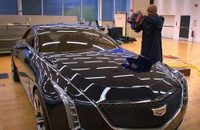3-D Scanning Big Part of Cadillac Elmiraj Design
 |
DETROIT--Nov 25, 2013: Structured-light 3-D scanning, an advanced measuring technology often used for fine art restoration and reproduction, helped create a “work of art” in the Cadillac Elmiraj concept car – appearing at the Los Angeles International Auto Show through Dec. 1.
3-D scanning uses projected light patterns and an advanced camera to capture three-dimensional shapes and translate them into math data that can be manipulated in digital modeling programs. Developers of Elmiraj, a modern update of a classic two-door grand coupe, extensively used the digital mapping technology.
“With the Elmiraj, we were able to use 3-D scanning as the bridge between traditional hand-sculpting teams who work in clay and digital modeling design teams who work in math,” said Frank Saucedo, director of General Motors’ North Hollywood Advanced Design Studio. “Our ability to scan the clay model with speed and precision and go from the digital tools to the hands of a craftsman and vice versa was extremely valuable.”
3-D scanning plays an increasingly important role in car design, which typically starts when a 2-D image is turned into a 3-D mathematical rendering. Math models serve as the basis for computer-controlled milling and hand-modeling in clay. 3-D scanners allow designers to quickly reverse engineer and update the master math model. Changes made to the math model are in turn updated in the physical model by milling the clay.
GM has used 3-D scanning since 2001, more on clay interior and exterior properties than drivable concept cars. Elmiraj is an exception. GM’s Design Center Fabrication Shops in Warren, Mich. and Advanced Design Studio in California used 3-D scanning to validate nearly every pattern, mold and part during each phase of the vehicle build.
“It provides a means of recording every design change with the utmost accuracy,” said David Bolognino, director of GM Design Fabrication Operations. “A scan can even reveal the need to take a step back to a previous iteration, and 3-D scanning makes it relatively easy to do.”
3-D scanners project a light pattern onto the vehicle surface while a camera looks for distortions that represent curves or contours, and records where the object is in space and its orientation. Each scan is digitally stitched together until the complete vehicle is captured. That data can be uploaded into a computer-controlled milling machine to create a full-scale model. A portion of the vehicle can be transferred to a 3-D fabricator for a rapid prototype part.
GM executes tens of thousands of scans every year. Laser-based and structured white and blue light scanning is also used in engineering applications, competitive benchmarking and in assembly plants for trouble-shooting part irregularities.
“Thanks in part to 3-D scanning, we can translate surface from a scale model to a full-size model in less than one week now,” said Bill Mattana, senior manager of global surface creation at GM’s Warren Design Center. “Not only is Elmiraj a stunningly beautiful concept car, it served as a tremendous opportunity for extending our use of 3-D scanning.”


